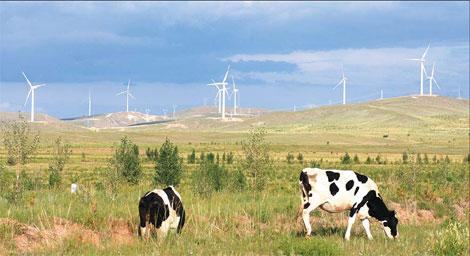
Wind power generators in Xilin Gol League, Inner Mongolia autonomous region. [China Daily]
Inner Mongolia autonomous region's Xilin Gol League, which has the richest brown coal reserves in China, plans to build 24 large-scale coal mines and eight clusters of coal-fired power plants during the 12th Five-Year-Plan (2011-2015), the local government said.
Statistics show China will have a total installed power capacity of 1.29 billion kW by 2015, 27 percent higher than the current level.
However, the economic zones around the Bohai Sea will require an installed power capacity of more than 60 million kW.
Xilin Gol League, situated inland from the Bohai Sea, is seizing the opportunity to expand the regional economy by accelerating the development of both fossil and renewable energies.
The local government is planning to build coal production plants in the center and east of the area, according to Xin Weidong, deputy director of Xilin Gol League Development and Reform Commission. The plants will produce 237 million tons of coal annually by 2015.
"Xilin Gol League is aiming to transform itself from an agriculture-based area into a national energy resource and production base," he said.
According to the plan, coal-fired power plants will have more than 28 million kW installed capacity by 2015, with installed wind power capacity of 5 million kW.
The potential raw coal markets for Xilin Gol League are the provincial regions within a 600 km radius, including Jilin, Liaoning and Hebei provinces, and the Inner Mongolia autonomous region.
Meanwhile, the markets for the power produced will be cities and areas within 1,000 km, including Beijing, Tianjin, Shandong, Jilin, Liaoning, Hebei and Henan.
Local officials believe there will be a growing demand for coal, to provide power for a smart grid project and a long-distance electricity network.
However, some experts are cautious about the plan.
Ren Qingzheng, deputy chief engineer of China International Engineering Consulting Corporation, said the price of electricity sold to the regions could pose a problem.
"They need to take the price into account," said Ren. "Personally, I don't think 0.8 yuan (12 cents) per kWh is acceptable." Another possible headache is the industrial water supply. At present, supplies of surface water for local industrial production equate to 229 million tons per year.
That is enough to support the production of 250 million tons of raw coal, 8 million tons of chemically adapted coal, and 40 million kW of electricity.
However, as the project develops, greater supplies of water will be needed. That has prompted Xilin Gol League government to conduct research on a desalinization program for sea water and a transfer program.
Zhang Yusheng, senior engineer at the energy industry development department of China International Engineering Consulting Corporation, suggested the local government should reconsider the overall arrangement of the power plants and coal mines. He added that water source location and environmental protection should also be considered to ensure that the projects are as environmentally friendly as possible.





